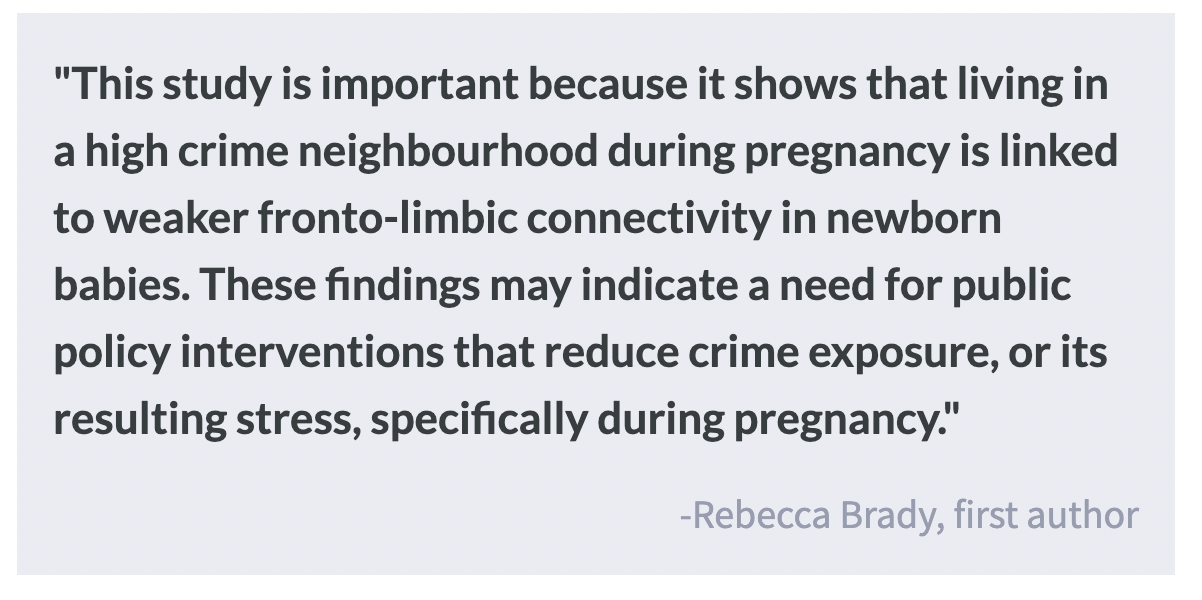The Effects of Living in High Crime Neighborhoods on Neonatal Brain Function
Post by Elisa Guma
The takeaway
Living in neighborhoods with high rates of crime has an impact on neonatal brain activity at birth, and this is mediated by maternal psychosocial stress. Weaker neonatal brain connectivity in some areas of the brain is directly associated with higher crime rates.
What's the science?
Maternal exposure to stress and adversity during pregnancy has been shown to impact fetal brain development, with lasting effects in postnatal life. Exposure to adversity may increase mothers’ stress and inflammatory factors, which may cross the placenta and interfere with fetal development. Previous work has found that mothers living in high-crime neighborhoods may not only have an increased risk of being victims of crime (a significant risk factor) but also experience higher levels of psychological stress. This week in Biological Psychiatry, Brady and colleagues investigate the relationship between neighborhood crime and neonatal brain function at birth.
How did they do it?
Mother-infant pairs were recruited as part of a larger birth-cohort study at Washington University in St. Louis. Shortly after birth, fed and swaddled neonates, underwent T2-weighted structural magnetic resonance and resting-state functional imaging. Reliable fetal brain networks were identified and connections between limbic regions (amygdala, hippocampus, thalamus) and frontal networks (anterior default mode network, anterior frontal-parietal network) were examined.
Crime data was obtained from a commercial database with data from law enforcement agencies and sorted into two categories: violent (i.e., crimes committed against persons such as murder, rape, robbery, and aggravated assault) or property crimes (i.e., burglary, larceny, and motor vehicle theft). Maternal addresses at birth were used to determine their block level crime exposure.
The authors also assessed potential protective actors or additive factors of socioeconomic status, referred to as “advantage”. This included family income relative to household size, insurance status, maternal education, area deprivation index (based on census data ranking neighborhood socioeconomic status based on income, education, employment, and housing quality), and maternal nutrition. At each trimester during pregnancy, measures of psychosocial stress were obtained, including measures of maternal depression, lifetime stressor exposure, and racial discrimination.
Researchers investigated the effects of prenatal exposure to crime on fronto-limbic connectivity as alterations in their connectivity have been previously associated with violent crime exposure, correcting for “advantage”. Potential mediating effects of maternal psychosocial stress were also investigated.
What did they find?
The authors found that disadvantaged mothers tended to live in areas with higher crime rates, but were widely distributed across both safe and dangerous neighborhoods, whereas advantaged mothers almost exclusively lived in areas with lower crime levels. Additionally, the women living in higher crime neighborhoods had higher psychosocial stress during pregnancy.
Exposure to violent and property crime during pregnancy, when correcting for “advantage”, was related to weaker connectivity between neonates' thalamus and anterior default mode network. Exposure to violent crime was additionally related to weaker amygdala-hippocampus connectivity. Furthermore, maternal psychosocial stress partially mediated the direct associations between the thalamus and anterior default mode network for both violent and property crimes.
What's the impact?
These important findings indicate that living in neighborhoods with objectively higher violent and property crime rates may have specific effects on neonatal brain function above and beyond those due to living in impoverished areas. Additionally, these effects may be mediated by maternal psychosocial stress associated with these circumstances. The work presented here sheds light on the pervasive, intergenerational effects of crime, which disproportionately impact minority communities. Future work should investigate the long-term impact of this prenatal exposure.


